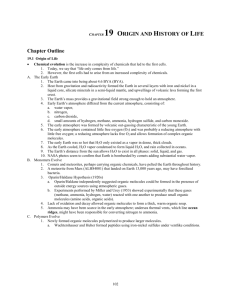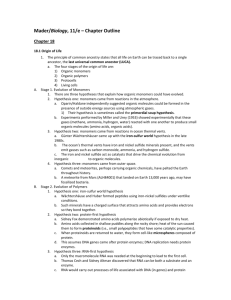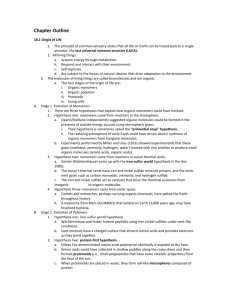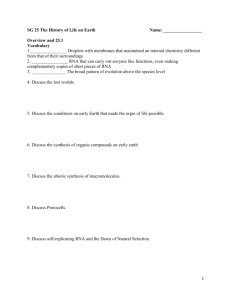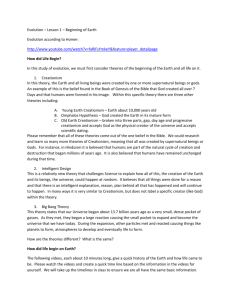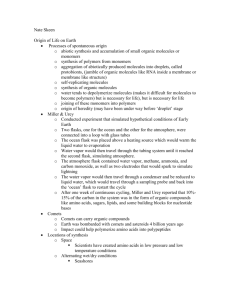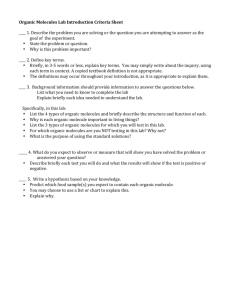CHAPTER 19 ORIGIN AND HISTORY OF LIFE
advertisement
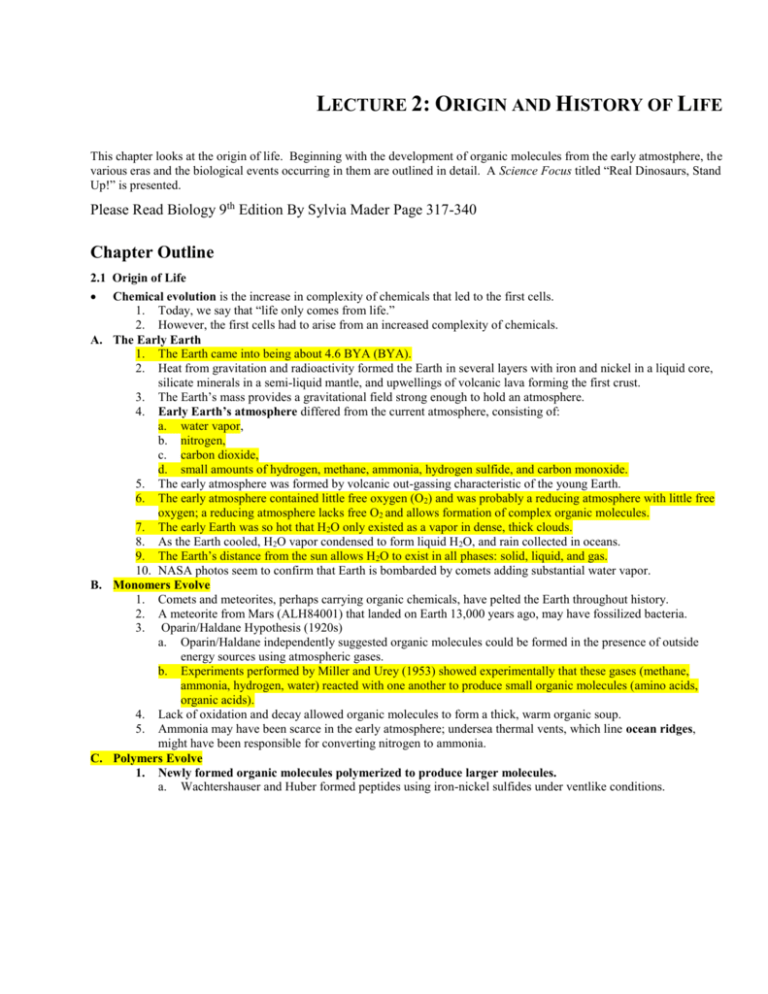
LECTURE 2: ORIGIN AND HISTORY OF LIFE This chapter looks at the origin of life. Beginning with the development of organic molecules from the early atmostphere, the various eras and the biological events occurring in them are outlined in detail. A Science Focus titled “Real Dinosaurs, Stand Up!” is presented. Please Read Biology 9th Edition By Sylvia Mader Page 317-340 Chapter Outline 2.1 Origin of Life Chemical evolution is the increase in complexity of chemicals that led to the first cells. 1. Today, we say that “life only comes from life.” 2. However, the first cells had to arise from an increased complexity of chemicals. A. The Early Earth 1. The Earth came into being about 4.6 BYA (BYA). 2. Heat from gravitation and radioactivity formed the Earth in several layers with iron and nickel in a liquid core, silicate minerals in a semi-liquid mantle, and upwellings of volcanic lava forming the first crust. 3. The Earth’s mass provides a gravitational field strong enough to hold an atmosphere. 4. Early Earth’s atmosphere differed from the current atmosphere, consisting of: a. water vapor, b. nitrogen, c. carbon dioxide, d. small amounts of hydrogen, methane, ammonia, hydrogen sulfide, and carbon monoxide. 5. The early atmosphere was formed by volcanic out-gassing characteristic of the young Earth. 6. The early atmosphere contained little free oxygen (O2) and was probably a reducing atmosphere with little free oxygen; a reducing atmosphere lacks free O2 and allows formation of complex organic molecules. 7. The early Earth was so hot that H2O only existed as a vapor in dense, thick clouds. 8. As the Earth cooled, H2O vapor condensed to form liquid H 2O, and rain collected in oceans. 9. The Earth’s distance from the sun allows H2O to exist in all phases: solid, liquid, and gas. 10. NASA photos seem to confirm that Earth is bombarded by comets adding substantial water vapor. B. Monomers Evolve 1. Comets and meteorites, perhaps carrying organic chemicals, have pelted the Earth throughout history. 2. A meteorite from Mars (ALH84001) that landed on Earth 13,000 years ago, may have fossilized bacteria. 3. Oparin/Haldane Hypothesis (1920s) a. Oparin/Haldane independently suggested organic molecules could be formed in the presence of outside energy sources using atmospheric gases. b. Experiments performed by Miller and Urey (1953) showed experimentally that these gases (methane, ammonia, hydrogen, water) reacted with one another to produce small organic molecules (amino acids, organic acids). 4. Lack of oxidation and decay allowed organic molecules to form a thick, warm organic soup. 5. Ammonia may have been scarce in the early atmosphere; undersea thermal vents, which line ocean ridges, might have been responsible for converting nitrogen to ammonia. C. Polymers Evolve 1. Newly formed organic molecules polymerized to produce larger molecules. a. Wachtershauser and Huber formed peptides using iron-nickel sulfides under ventlike conditions. b. Such minerals have a charged surface that attracts amino acids and provides electrons so they bond together. 2. Protein-first Hypothesis a. Sidney Fox demonstrated amino acids polymerize abiotically if exposed to dry heat. b. Amino acids collected in shallow puddles along the rocky shore; heat of the sun caused them to form proteinoids (i.e., small polypeptides that have some catalytic properties). c. When proteinoids are returned to water, they form cell-like microspheres composed of protein. d. This assumes DNA genes came after protein enzymes; DNA replication needs protein enzymes. 3. The Clay Hypothesis a. Graham Cairns-Smith suggests that amino acids polymerize in clay, with radioactivity providing energy. b. Clay attracts small organic molecules and contains iron and zinc atoms serving as inorganic catalysts for polypeptide formation. c. Clay collects energy from radioactive decay and discharges it if temperature or humidity changes. d. If RNA nucleotides and amino acids became associated so polypeptides were ordered by and helped synthesize RNA, then polypeptides and RNA arose at the same time. 4. RNA-first Hypothesis a. Only the macromolecule RNA was needed at the beginning to lead to the first cell. b. Thomas Cech and Sidney Altman discovered that RNA can be both a substrate and an enzyme. c. RNA would carry out processes of life associated with DNA (in genes) and protein enzymes. d. Supporters of this hypothesis label this an “RNA world” 4 BYA. D. A Protocell Evolves 1. Before the first true cell arose, there would have been a protocell or protobiont. 2. A protocell would have a lipid-protein membrane and carry on energy metabolism. 3. Fox showed that if lipids are made available to microspheres, lipids become associated with microspheres producing a lipid-protein membrane. 4. Oparin demonstrated a protocell could have developed from coacervate droplets. a. Coacervate droplets are complex spherical units that spontaneously form when concentrated mixtures of macromolecules are held in the right temperature, ionic composition, and pH. b. Coacervate droplets absorb and incorporate various substances from the surrounding solution. c. In a liquid environment, phospholipid molecules spontaneously form liposomes, spheres surrounded by a layer of phospholipids; this is called the “membrane-first” hypothesis. d. A protocell could have contained only RNA to function as both genetic material and enzymes. 5. If a protocell was a heterotrophic fermenter living on the organic molecules in the organic soup that was its environment, this would indicate heterotrophs preceded autotrophs. a. A heterotroph is an organism that cannot synthesize organic compounds from inorganic substances and therefore must take in preformed organic compounds. b. An autotroph is an organism that makes organic molecules from inorganic nutrients. If the protocell evolved at hydrothermal vents, it would be chemosynthetic and autotrophs would have preceded heterotrophs. 7. The first protocells may have used preformed ATP, but as supplies dwindled, natural selection would favor cells that could extract energy from carbohydrates to transform ADP to ATP. 8. Since glycolysis is a common metabolic pathway in living things, it evolved early in the history of life. 9. As there was no free O2, it is assumed that protocells carried on a form of fermentation. 10. The first protocells had a limited ability to break down organic molecules; it took millions of years for glycolysis to evolve completely. 11. Fox has shown that a microsphere has some catalytic ability; Oparin found that coacervates incorporate enzymes if they are available in the medium. A Self-Replication System Evolves 1. In living systems, information flows from DNA → RNA → protein; it is possible that this sequence developed in stages. 2. The RNA-first hypothesis suggests that the first genes and enzymes were RNA molecules. a. These genes would have directed and carried out protein synthesis. b. Ribozymes are RNA that acts as enzymes. c. Some viruses contain RNA genes with a protein enzyme called reverse transcriptase that uses RNA as a template to form DNA; this could have given rise to the first DNA. 3. The protein-first hypothesis contends that proteins or at least polypeptides were the first to arise. a. Only after the protocell develops complex enzymes could it form nucleic acids from small molecules. b. Because a nucleic acid is complicated, the chance that it arose on its own is minimal. c. Therefore, enzymes are needed to guide the synthesis of nucleotides and then nucleic acids. 4. Cairns-Smith suggests that polypeptides and RNA evolved simultaneously. a. The first true cell would contain RNA genes that replicated because of the presence of proteins; they become associated in clay in such a way that the polypeptides catalyzed RNA formation. b. This eliminates the chicken-and-egg paradox; both events happen at the same time. 5. Once the protocell was capable of reproduction, it became a true cell and biological evolution began. a. After DNA formed, the genetic code still had to evolve to store information. b. Because the current code is subject to fewer errors than other possible codes, and because it minimizes mutations, it likely underwent a natural selection process. 6. Most biologists suspect life evolved in 4 basic steps. a. Abiotic synthesis of organic molecules such as amino acids occurred in the atmosphere or at hydrothermal vents. b. Monomers joined together to form polymers at seaside rocks or clay, or at vents; the first polymers could have been proteins or RNA or both. c. Polymers aggregated inside a plasma membrane to make a protocell that had limited ability to grow; if it developed in the ocean it was a heterotroph, if at a hydrothermal vent, a chemoautotroph. d. Once the protocell contained DNA genes or RNA molecules, it was a true cell. History of Life Fossils Tell a Story 1. A fossil is the remains or traces of past life, usually preserved in sedimentary rock. 2. Most dead organisms are consumed by scavengers or decompose. 3. Paleontology is the study of fossils and the history of life, ancient climates, and environments. 4. Sedimentation has been going on since the Earth was formed; it is an accumulation of particles forming a stratum, a recognizable layer in a stratigraphic sequence laid down on land or in water. 5. The sequence indicates the age of fossils; a stratum is older than the one above it and younger than the one below it. Relative Dating of Fossils 1. Strata of the same age in England and Russia may have different sediments. 2. However, geologists discovered that strata of the same age contain the same fossils, termed index fossils. 3. Therefore, fossils can be used for the relative dating of strata. 4. A particular species of fossil ammonite is found over a wide range and for a limited time period; therefore, all strata in the world that contain this ammonite are of the same age. 5. However, relative dating does not establish the absolute age of fossils in years. Absolute Dating of Fossils 6. E. 2.2 A. B. C. 1. 2. Absolute dating relies on radioactive dating to determine the actual age of fossils. Radioactive isotopes have a half-life, the time it takes for half of a radioactive isotope to change into a stable element. 3. Carbon 14 (14C) is a radioactive isotope contained within organic matter. a. Half of the carbon 14 (14C) will change to nitrogen 14 (14N) every 5,730 years. b. Comparing 14C radioactivity of a fossil to modern organic matter calculates the age of the fossil. c. After 50,000 years, the 14C radioactivity is so low it cannot be used to measure age accurately. 4. It is possible to determine the ratio of potassium 40 ( 40K) and argon 40 to date rocks and infer the age of a fossil. D. The Precambrian Geologists have devised the geological timescale, which divides the history of Earth into eras, and then periods and epochs. 1. Life arose in the Precambrian Era. a. The Precambrian encompasses 87% of the geologic time scale. b. Early bacteria probably resembled the archaea that live in hot springs today. c. 3.8 BYA, the first chemical fingerprints of complex cells occur; at 3.46 BYA, photosynthetic prokaryotic cells appear. d. Boulders called stromatolites from this early time resemble living stromatolites with cyanobacteria in the outer surface. e. Oxygen-releasing photosynthesis by cyanobacteria in stromatolites caused the atmosphere to become oxidizing rather than reducing. f. By 2 BYA, oxygen levels were high enough that anaerobic prokaryotes were declining. g. Accumulation of O2 caused extinction of anaerobic organisms and the rise of aerobic organisms. h. O2 forms ozone or O3 in the upper atmosphere, contributing to the ozone shield and blocking ultraviolet radiation from reaching the Earth’s surface; this allowed organisms to live on land. 2. Eukaryotic Cells Arise a. The eukaryotic cell, which arose 2.1 BYA, is always aerobic and contains a nucleus and organelles. b. The Endosymbiotic Hypothesis 1) Mitochondria were probably once free-living aerobic prokaryotes. 2) Chloroplasts were probably once free-living photosynthetic prokaryotes. 3) A nucleated cell probably engulfed these prokaryotes that became various organelles. 4) Cilia and flagella may have originated from slender undulating prokaryotes that attached to the host cell. 3. Multicellularity Arises a. It is not known exactly when multicellular organisms appeared; they would have been microscopic. b. Separating germ cells from somatic cells may have contributed to the diversity of organisms. c. Fossils of the Ediacara Hills of South Australia, from about 600-545 MYA, were soft-bodied early invertebrates. 1) These bizarre animals lived on mudflats in shallow marine waters. 2) They lacked internal organs and could have absorbed nutrients from the sea. E. The Paleozoic Era 1. The Paleozoic Era lasted over 300 million years and was a very active period with three major mass extinctions. a. An extinction is the total disappearance of a species or higher taxonomic group. b. Mass extinction is the disappearance of a large numbers of species or higher groups in a short geological time, just a few million years. 2. Cambrian Animals a. The Cambrian Period saw invertebrates flourish; invertebrates lack a vertebral column. b. Today’s invertebrates all trace their ancestry to the Cambrian Period, and possibly earlier. c. A molecular clock, based on a fixed rate of changes in base pair sequences, allows us to trace backward how long current species have evolved separately. d. Why fossils are easy to find in the Cambrian but not before is a complex question; most likely the animals evolved earlier but without outer skeletons. e. Cambrian seafloors were dominated by trilobites, now extinct, that had armored exoskeletons. f. Perhaps the evolution of exoskeletons was due to the presence of plentiful O 2 in the atmosphere. g. A skeleton may have been due to the increased pressures of predation. 3. Invasion of Land a. b. F. G. 2.3 A. Early in the Ordovician Period, marine algae expanded to freshwater. In the Silurian Period, vascular plants invaded land and later flourished in warm swamps in the Carboniferous Period. c. Spiders, centipedes, mites and millipedes all preceded the appearance of insects on land. d. The appearance of wings on insects in the Carboniferous Period allowed insects to radiate into a diverse group. e. The vertebrate line of descent began in the early Ordovician Period. f. The Devonian Period is called the Age of Fishes and saw jawless and then jawed fishes, including both cartilaginous and ray-finned fishes. g. The Carboniferous Period was an age of coal-forming forests with an abundance of club mosses, horsetails, and ferns. 1) It is called the “Age of the Amphibians” because amphibians diversified at this time. 2) Early vascular plants and amphibians were larger and more abundant during the Carboniferous Period; a climate change to colder and drier began the process that produced coal. The Mesozoic Era 1. Although there was a mass extinction at the end of the Paleozoic, evolution of some plants and animals continued into the Triassic, the first period of the Mesozoic Era. 2. The Triassic period a. Gymnosperms flourished, especially cycads; the Triassic and Jurassic are called the “Age of Cycads.” b. One group of reptiles, the therapsids, had the first mammal features. c. Reptiles, originating in the Permian, underwent adaptive radiation. 3. The Jurassic Period a. Many dinosaurs flourished in the sea, on land and in air. b. Controversy surrounds dinosaurs being ectothermic or endothermic. 4. The Cretaceous Period a. A new Chinese fossil, Jeholodens, reveals an early mammal with a long snout but sprawling reptile-like hind limbs. b. The era of dinosaurs ended in a mass extinction in which dinosaurs, most reptiles, and many marine organisms perished. The Cenozoic Era 1. The Cenozoic Era is divided into the Tertiary and the Quaternary Periods. 2. During the Cenozoic Era, mammals with hair and mammary glands diversified and human evolution began. 3. Mammalian Diversification a. During the Paleocene Epoch, mammals were small and resembled rats. b. In the Eocene Epoch, all of the modern orders of mammals had developed. c. Many of the types of herbivores and carnivores of the Oligocene Epoch are extinct today. 4. Evolution of Primates a. Flowering plants were diverse and plentiful by the Cenozoic Era; primates were adapted to living in flowering trees. b. The first primates were small squirrel-like animals; from them evolved the first monkeys and apes. c. Apes diversified during the Miocene and Pliocene Epochs; this includes the first hominids, the group that includes humans. d. During the Tertiary Period, the world’s climate cooled with the last two epochs known as the Ice Age. e. The Pleistocene Epoch saw many large sloths, beavers, wolves, bison, woolly rhinoceroses, mastodons, and mammoths; modern humans arose and may have contributed to extinction. Factors That Influence Evolution Continental Drift 1. Earth’s crust is dynamic, not immobile as was once thought. 2. In 1920, German meteorologist Alfred Wegener presented data from across disciplines supporting continental drift. 3. Continental drift was confirmed in the 1960s; the continents moved with respect to one another. 4. During the Permean Period, the continents were joined to form one supercontinent called Pangaea which later divided into Gondwana and Laurasia and then split to form today’s configuration. 5. Continental drift explains why the coastlines of several continents (e.g., the outline of the west coast of Africa and that of the east coast of South America) are mirror images of each other. 6. The same geological structures (e.g., mountain ranges) are found in many areas where continents once touched. 7. Continental drift explains unique distribution patterns of several fossils (e.g., species of the seed fern Glossopteris). 8. Continental drift also explains why some fossils (e.g., reptiles Cynognathus and Lystrosaurus) are found on different continents. 9. Continental drift explains why Australia, South America, and Africa have distinctive mammals; current mammalian biological diversity is the result of isolated evolution on separate continents. B. Plate Tectonics 1. Plate tectonics is the study of the behavior of the Earth’s crust in terms of moving plates that are formed at ocean ridges and destroyed at subduction zones. 2. Ocean ridges are ridges on ocean floors where oceanic crust forms; regions in oceanic crust where molten rock rises and material is added to the ocean floor result in seafloor spreading. 3. Seafloor spreading is the lateral movement of oceanic crust away from ocean ridges due to material added to the ocean floor. 4. Subduction zones are regions where oceanic crust collides with the continental crust, causing the oceanic crust to descend into the mantle where it is melted. 5. Where the ocean floor is at the leading edge of a plate, a deep trench forms bordered by volcanoes or volcanic island chains. 6. Two continents colliding form a mountain range (e.g., the Himalayas are the result of the collision of India and Eurasia). 7. Transform boundaries are regions where two crustal plates meet and scrape past one another resulting in relatively frequent earthquakes. C. Mass Extinctions 1. Five mass extinctions occurred at the ends of the Ordovician, Devonian, Permian, Triassic, and Cretaceous periods. 2. Mass extinctions have been attributed to tectonic, oceanic, and climatic changes. 3. Walter and Louis Alvarez proposed that the Cretaceous extinction was due to a bolide (an asteroid that explodes producing meteorites) striking the Earth. a. A layer of iridium soot has been identified in the Cretaceous clay, the correct strata. b. A huge crater near the Yucatan is the impact site. c. The effect would have resembled a worldwide atomic explosion. 4. David Raup and John Sepkoski proposed that marine fossils show mass extinctions every 26 million years, in periodicity with astronomical movement through the galaxy. 5. Continental drift contributed to Ordovician extinction; Gondwanaland arrived at the south pole and glaciers chilled oceans and land until Gondwanaland drifted away from the pole. 6. The Devonian extinction may have been a bolide event; this saw an end to 70% of the marine invertebrates; other possibilities include drifting back toward the south pole. 7. The Permian extinction was very severe; 90% of ocean species and 70% of land species disappeared perhaps due to an excess of carbon dioxide due to a change in ocean circulation due to a lack of polar ice caps. 8. The Triassic extinction has been attributed to meteorite collision with Earth; a crater in Central Quebec may have been the impact site.
